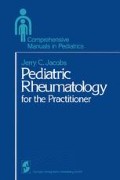Abstract
The pathogenesis of rheumatic diseases remains an enigma. Errors of immunologic regulatory mechanisms seem to be involved.1 However, even when an inducer of disease, such as the Streptococcus in acute rheumatic fever or Shigella, Salmonella, or Yersinia in spondyloarthritis, has finally been identified, the effector or suppressor mechanisms that lead to or prevent the subsequent development of the disease or which cause it to remit remain obscure. Genetic, infectious, and immunologic factors can usually all be implicated. The relationships between these various influences on the pathogenesis of a disease are extremely complex. Animals provide useful models for studying these interactions (Table 9.1).
Access this chapter
Tax calculation will be finalised at checkout
Purchases are for personal use only
Preview
Unable to display preview. Download preview PDF.
References
Janossy G, Duke O, Poulter LW, et al.: Rheumatoid arthritis: A disease of T-lymphocyte/macrophage immunoregulation. Lancet 2: 839–842, 1981.
Chess L: Cellular immunology. In: Cohen AS (ed.) The Science and Practice of Clinical Medicine, vol. 4. Grune and Stratton, New York, 1979, pp. 378–388.
Geha RS: Current concepts in immunology: Regulation of the immune response by idiotypic-antiidiotypic interactions. N Engl J Med 305: 25–28, 1981.
Gershon RK: Clonal selection and after, and after. (Editorial) N Engl J Med 300: 1105–1107, 1979.
Norton WL: Aleutian mink and New Zealand mice models of viral induced connective tissue disease. Rheumatology (Basel) 3:194–223, 1970; The Immunochemistry and Biochemistry of Connective Tissue and its Disease States. Karger, Basel, München, New York.
Milich DR, Gershwin ME: The pathogenesis of autoimmunity in New Zealand mice. Semin Arthritis Rheum 10: 111–147, 1980.
Whaley K, Hughes GRV, Webb J: Systemic lupus erythematosus in man and animals. In: Buchanan WW, Dick WC (eds.) Recent Advances in Rheumatology, vol. 1. Churchill Livingstone, New York, 1976, pp. 67–136.
Talal N: Disordered immunologic regulation and autoimmunity. Trans Rev 31: 240263, 1976.
Steinberg AD, Reinertsen JL: Lupus in New Zealand mice and in dogs. Bull Rheum Dis 28: 940–947, 1978.
Henson JB, Crawford TB: The pathogenesis of virus-induced arterial disease-Aleutian disease and equine viral arteritis. Adv Cardiol 13: 183–191, 1974.
Mikkelsen WM (ed.): Twenty-third rheumatism review. Arthritis Rheum 21 (Suppl. 8): R177–R196, 1978.
Walker SE, Schnitzer B: Resistance to therapy in mature Palmerston North mice treated with cyclophosphamide or hydrocortisone sodium succinate. Arthritis Rheum 23: 539–544, 1980.
Pearson CM: Arthritis in animals. In: McCarty DU (ed.) Arthritis and Allied Conditions, 9th ed. Lea and Febiger, Philadelphia, 1979, pp. 308–319.
Chronic arthritis of rabbits induced by mycoplasmas. I. Clinical, microbiologic and histologic features. Arthritis Rheum 23: 825–845, 1980.
Stuart JM, Cremer MA, Kang AH, et al.: Collagen-induced arthritis in rats: Evaluation of early immunologic events. Arthritis Rheum 22: 1344–1351, 1979.
Chang Y, Pearson CM, Abe C: Adjuvant polyarthritis. IV. Induction by a synthetic adjuvant: Immunologic, histopathologic and other studies. Arthritis Rheum 23: 6271, 1980.
Morgan G, Peter JV, Newbould BB: Experimental allergic myositis in rats. Arthritis Rheum 14: 599–609, 1971.
Statsny P, Stembridge VA, Ziff M: Homologous disease, a model for human autoimmune disease. Arthritis Rheum 6: 64–69, 1963.
Brinckerhoff CE, McMillan RM, Dayer JM, et al.: Inhibition by retinoic acid of collagenase production in rheumatoid synovial cells. N Engl J Med 303: 432–436, 1980.
Steinberg J, Tsukamoto S, Sledge CB: A tissue culture model of cartilage breakdown in rheumatoid arthritis. III. Effects of antirheumatic drugs. Arthritis Rheum 22: 877885, 1979.
Schwartz ER, Greenwald RA: Experimental models of osteoarthritis. Bull Rheum Dis 30: 1030–1033, 1980.
Palmoski MJ, Colyer RA, Brandt KD: Joint motion in the absence of normal loading does not maintain normal articular cartilage. Arthritis Rheum 23: 325–334, 1980.
Author information
Authors and Affiliations
Rights and permissions
Copyright information
© 1982 Springer Science+Business Media New York
About this chapter
Cite this chapter
Jacobs, J.C. (1982). Models of Connective Tissue Disease. In: Pediatric Rheumatology for the Practitioner. Comprehensive Manuals in Pediatrics. Springer, New York, NY. https://doi.org/10.1007/978-1-4757-6153-5_9
Download citation
DOI: https://doi.org/10.1007/978-1-4757-6153-5_9
Publisher Name: Springer, New York, NY
Print ISBN: 978-1-4757-6155-9
Online ISBN: 978-1-4757-6153-5
eBook Packages: Springer Book Archive

